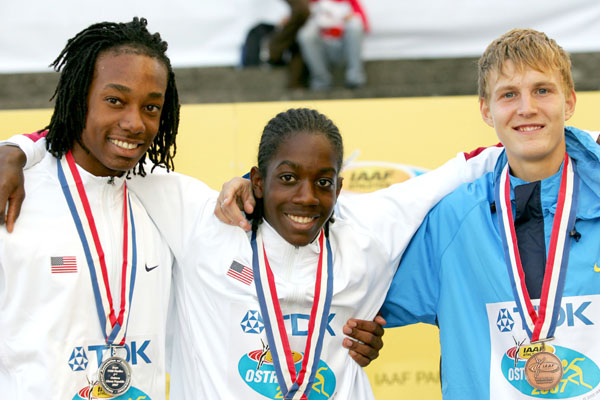In USATF youth track, hurdling begins at the11-12 year-old age group with the 80 meter hurdles for both boys and girls. At the 13-14 year-old age group, they move up to the 100m distance, with the boys running over 33” hurdles and the girls running over 30” hurdles. Also, both boys and girls begin running the 200m hurdles. Then, at the 15-16 year-old age group, comes what I feel to be a huge leap: the boys go from the 100m race over 33” to the 110 distance over 39” hurdles. The hurdles are six inches higher, the distance is ten meters longer, and there is also much more ground to cover between the hurdles. At the same age group, the long hurdles for both boys and girls extend from 200 meters over five hurdles to 400 meters over 10 hurdles. In this article I will discuss the effects of this major transition on the athletes themselves and make suggestions for changes.
Firstly, I think it would be better for the boys to move from 33” to 36” when they turn fifteen instead of going straight to the 39’s. Transitioning to a hurdle that is six inches higher than what you’re used to is just too hard for the majority of athletes. Yes, the athletes would be entering high school and would still be running over 39’s in their high school meets, but going back down to the 36’s in the summer youth meets would be good for their confidence and give them something to look forward to. Most boys are still growing at the age of fifteen and might not be tall enough or strong enough to negotiate the 39’s effectively. In the effort to “pick up where they left off” over the lower hurdles, they might develop bad habits technically because they’re trying too hard to be competitive right off the bat. If the hurdles were set at 36”, the athletes could make a smoother, more natural transition.
Speaking of the need for smooth transitions, the jump from the from 200 meter hurdles to the 400 meter hurdles is too much for both boys and girls. A lot of kids look downright awful over the 400m distance. It can be hard to watch. Some hit the wall after the fifth hurdle, some make it through seven, and there are those chosen few who look strong for the whole race. But for the most part, fifteen-year-olds are just not ready for the 400 meter hurdles. Moving up to the 300 meter distance would make more sense because they’d be adding only another 100 meters to what they had been doing in the previous age group as opposed to doubling the distance. Plus, most states feature the 300 meter hurdles as their long hurdle race in high school anyway. The 300 meter distance is challenging enough and it gives the athletes a chance to grow into the 400m distance once they reach the 17-18 age group. As with the 110’s, the 300’s would give kids the confidence necessary to continue to develop.
I must acknowledge that the higher hurdles for the boys in the sprint hurdles and the longer distance for boys and girls in the long hurdles are beneficial for those athletes at the top of the food chain. This past summer at the World Youth Games in the Czech Republic Wayne Davis and William Wynne both set new world youth records in the 110’s and 400’s, respectively. Such performances prove that being thrown into the fire of the 39’s and 400’s puts American youth athletes at an advantage over their counterparts from other countries. In almost every other area of the globe, 15-16 year-olds run over 36’s for the 110’s and 33’s for the 400’s. Running over 39’s and 36’s in high school and in youth track gave the Americans an advantage that obviously helped them in international competition. For Davis, the 36’s felt like he didn’t even have to hurdle at all, and for Wynne, the 33’s were a joke.

Wynne (left) and Davis (middle) adjusted well to the higher height and longer distance, which made things easy for them when racing over lower hurdles in Ostrava.
But the Davises and Wynnes of the world are the exceptions. Many kids have a huge fall-off when moving up from the 33’s to the 39’s, and from the 200’s to the 400’s, and can get discouraged to the point where they lose hope and quit.
Obviously, if such changes as I suggest were to be made, logistics would be an issue, as they always are when it comes to the hurdles. As it stands now, in youth track there are 80 meter hurdles for the 11-12 year olds, 100 meter hurdles at 30” for 13-14 year-old girls, 100 meter hurdles at 33” for 15-16 and 17-18 year-old girls and 13-14 year-old boys, and 39” hurdles for 15-16 and 17-18 boys. If the boys 15-16 hurdles were lowered to 36”, that would be another five or ten minutes worth of the hurdle crew adjusting the heights and weights of the hurdles. With the long hurdles, there aren’t many tracks that have markings for both the 300m and the 400m hurdles, so adding a 300m race for the 15-16 year olds could prove to be a nightmare for officials and meet directors. These are problems to consider, but they are not obstacles that cannot be overcome. In the long run, easing the transition from the 13-14 year-old age group to 15-16 year-old age group would benefit the kids and improve the quality of their performances.
© 2007 Steve McGill
